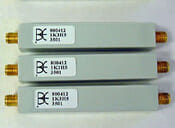 Low pass RF filter – RF Clean up Lowpass Filter
Low pass RF filter – RF Clean up Lowpass Filter
800412
Low pass RF filter: Model number 800412 is a Low pass RF filter in a coaxial package for interface outside the system package. The purpose of the Low pass RF filter is to eliminate unwanted interferences from adjacent channels. Electrical specifications are 1.5 to 1.0 VSWR maximum and 2.5 dba of insertion loss maximum at and below 2060 MHz. Rejection is 25 dBa minimum at 2110 MHz. Size is 2.75 x 0.5 x 0.5 inches and Input/outputs are SMA female connectors.
The first form of electronic filters or RF Filters are passive analog linear filters, constructed with resistors and capacitors or resistors and inductors. Known as RC and RL single-pole filters respectively. These simple filters have limited uses. For greater control of response form, bandwidth and transition bands, Multipole LC filters were invented. The original Multipole filter was the constant k filter, designed by George Campbell in 1910. Campbell’s filter is a ladder network based on transmission line theory. Together with improved filters by Otto Zobel and others, these filters are known as image parameter filters. A major step forward was taken by Wilhelm Cauer who founded the field of network synthesis around the time of World War II. Cauer’s theory allowed filters to be constructed that precisely followed some prescribed frequency function.
Passive filters
Passive designs of linear filters are based on combinations of resistors , inductors and capacitors . They are collectively known as passive filters, because they do not depend upon an external power supply and they do not contain active components like transistors.
Capacitors conduct high-frequency signals and block low-frequency signals, while inductors do the reverse. A filter in which the signal passes through an inductor, or in which a capacitor provides a path to ground, presents less attenuation to low-frequency signals than high-frequency signals and is therefore a low-pass filter. If the signal passes through a capacitor, or has a path to ground through an inductor, then the filter presents less attenuation to high-frequency signals than low-frequency signals and therefore is a high-pass filter. Resistors on their own have no frequency-selective properties, but are added to inductors and capacitors to determine the time-constants of the circuit, and therefore the frequencies to which it responds.
